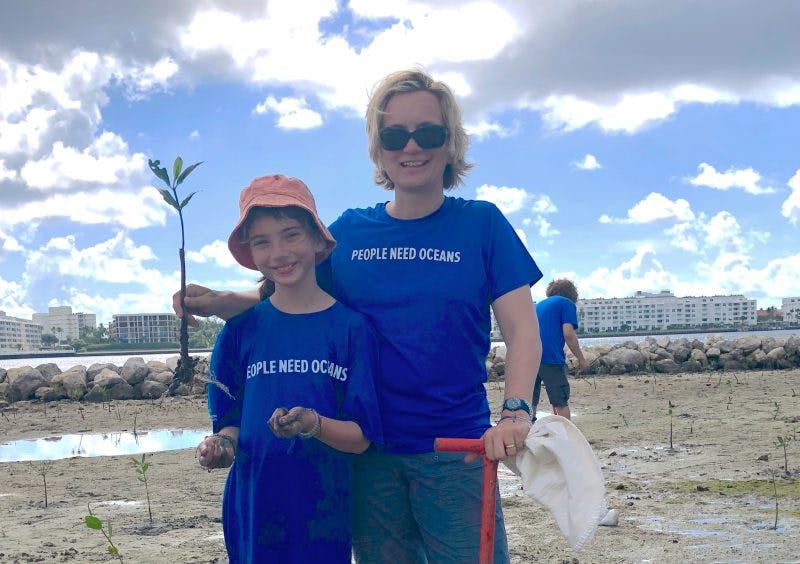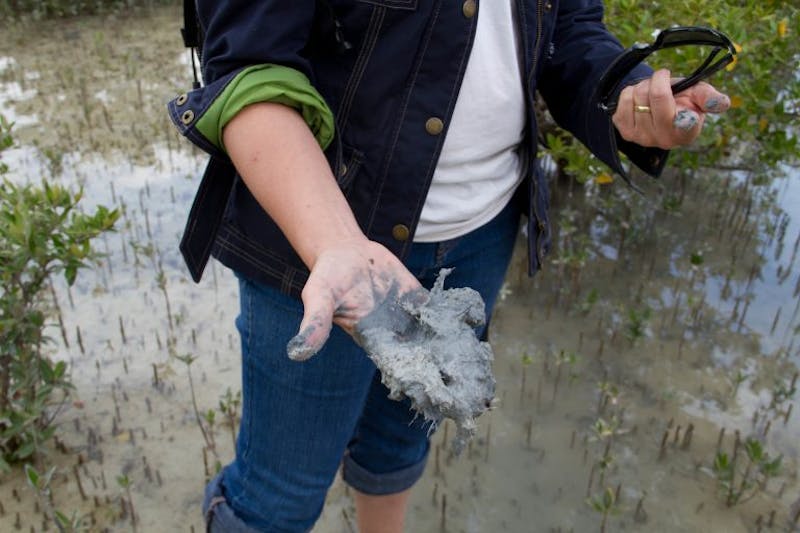Editor’s note: A recent survey found that 81 percent of Americans could not name a living scientist. No, not a single one. At Conservation International (CI), we have lots of scientists you should know. Here’s one.
Emily Pidgeon is senior director of the Blue Climate program within Conservation International’s Center for Oceans. Pidgeon focuses on coastal and ocean ecosystems as critical solutions to climate change, including “blue carbon” — the carbon stored naturally in mangrove forests and other coastal ecosystems.
Human Nature spoke with Pidgeon about her passion for protecting the oceans — and how a gig as a volunteer aquarium guide taught her a life-changing lesson.

Emily Pidgeon and her daughter, Bronwyn, planting mangroves together in Florida. (Photo courtesy of Emily Pidgeon)
Question: What made you want to study the ocean?
Pidgeon: I’m originally from Perth, in Western Australia. I think if you grow up on the beach in a special place, as I did, with white sand and deep blue water, at some point you realize how precious it is — and that you have to do everything you can to ensure it will be around for future generations.
Q: How did you turn your love for the ocean into a career in conservation?
P: Originally, I came to the U.S. (more years ago than I’m willing to admit) to go to graduate school. I completed a doctorate in environmental engineering at Stanford. After that, I was a scientist at the Scripps Institution of Oceanography, where I worked on tides in coastal areas and how they affect coastal communities.
After being a scientist for a while, I wanted to make my work useful, to apply it and see it make an impact on the world. So, about 13 years ago, I found my way to Conservation International. In my first year, I traveled around the world with our field teams, helping them with their technical problems related to oceans and coasts. It was wonderful because I got to experience the organization’s work in person, and I met people who are still my close friends today.

Surrounded by mangrove seedlings in Doha, Qatar, Emily Pidgeon examines mud to estimate its carbon storage capacity. (© Conservation International/photo by Molly Bergen)
At a certain point during that travel, it became clear that one of the biggest issues our teams and partners in the field were struggling with was climate change. So I asked them: How should we be thinking about climate change in the context of our ocean conservation work? From there, I built what’s known today as Conservation International’s Blue Climate program.
Q: How do you approach the topic of climate change with people of different backgrounds?
P: When I was a scientist at Scripps Institution of Oceanography, I volunteered at the local aquarium on Saturday afternoons. The public would come through the aquarium, and as they watched the flame-orange Garabaldi fish swim around the California kelp forest, they would ask me questions. And every week, without fail, someone would ask me a question that the science I had studied for so long had no answer for: What could they do to save that Garabaldi fish from pollution? Why should marine life be important to them? I realized that people had completely different perspectives to the one I experienced as an academic scientist — and that to communicate science, I not only needed to know how to talk about my science differently, but I also needed to learn to listen.
Ultimately, I value being able to talk about something as important as climate change with everyone it affects. This means having the scientific background to be able to work with the science community, but then also being able to talk to people in, say, a small community in the Philippines already experiencing the harsh impacts of climate change. Being the person who can link all of these pieces is only possible when you really listen to each one of these communities.
Q: Thinking back on all your travel, is there a particular community that stands out to you?
P: There is a group of the most inspiring women on Chira Island on the Pacific coast of Costa Rica. Any moment I think that life is hard, I reflect on what those women have achieved. They have overcome poverty and opposition from their families, community and beyond to bring income, education and security to their families. They built a fiberglass boat from scratch because there was no way of getting people from the island to the mainland if there was an emergency. It was these women who realized that their fish populations were depleted and that they needed to restore their mangroves. Conservation International’s team in Costa Rica has been supporting them for over a decade now, but it is the strength and determination of the women themselves that has given their communities a brighter future.
If you wonder why I do this, it’s for the women on Chira and the many others like them we work with around the world. Meeting these communities and seeing firsthand how vulnerable they are to the impacts of climate change is a life-changing experience every time, even after more than a decade working on these issues. Using science to make a difference to these people gives me joy and maintains my hope for the future.
Olivia DeSmit is a staff writer for Conservation International.